物理学专业英语
- 格式:ppt
- 大小:1.87 MB
- 文档页数:133

Physics in EnglishThe scientist does not study nature because it is useful;he studies it because he delights in it,and he delights in it because it is beautiful.If nature were not beautiful,it would not be worth knowing,and if nature were not worth knowing,life would not be worth living."------ Henri PoincareDepartment of PhysicsSchool of scienceXian Technological University 2012.9Chapter 1 What is Physics?Physics is natural science studying nature's LawsPhysics was called natural philosophy and fundamental science.The history of physicsThe history of physics encompasses two broad time periods in which classical physics and modern physics developed. Classical physics developed between 1600 and 1900. It embraces the general areas of physics known as mechanics, thermodynamics, and electromagnetism, culminating in relativity. Modern physics began developing between about 1890 and 1930, when it was realized that classical physics could not account for the newly discovered behavior of nature at the atomic and molecular level. Modern physics includes the theory of relativity as well as quantum mechanics and most of the subsequent new physics discovered and developed during the 20th century.Classical physicsClassical physics includes the traditional branches and topics that were recognized and well-developed before the beginning of the 20th century—classical mechanics, optics, thermodynamics, and electromagnetism. Classical mechanics is concerned with bodies acted on by forces and bodies in motion and may be divided into statics (study of the forces on a body or bodies at rest), kinematics (study of motion without regard to its causes), and dynamics (study of motion and the forces that affect it); Acoustics, the study of sound, is often considered a branch of mechanics because sound is due to the motions of the particles of air or other medium through which sound waves can travel and thus can be explained in terms of the laws of mechanics. Among the important modern branches of acoustics is ultrasonics, the study of sound waves of very high frequency beyond the range of human hearing. Optics, the study of light, is concerned not only with visible light but also with infrared and ultraviolet radiation, which exhibit all of the phenomena of visible light except visibility, e.g., reflection, refraction, interference, diffraction, dispersion, and polarization of light. Heat is a form of energy, the internal energy possessed by the particles of which a substance is composed; thermodynamics deals with the relationships between heat and other forms of energy. Electricity and magnetism have been studied as a single branch of physics since the intimate connection between them was discovered in the early 19th century; an electric current gives rise to a magnetic field and a changing magnetic field induces an electric current. Electrostatics deals with electric charges at rest, electrodynamics with moving charges, and magnetostatics with magnetic poles at restThe Emergence of Classical PhysicsClassical mechanics has its roots in the work of Johannes Kepler, who, between 1600 and 1619, became the first person to describe quantitatively and accurately the elliptic paths of the planets around the Sun.The problem of the shape of the planetary orbits was not easy to solve, because all historical observations of the planets were made from the Earth, itself a moving planet. Although a crude heliocentric(Sun-centered) model of the solar system using circular orbits was proposed by the Greek astronomer Aristarchus in the third century B.C. and resurrected by Copernicus in 1542,the planetary positions predicted by Copernicus were not as accurate as those found using Ptolemy's complicated geocentric (Earth-centered} model of the second century A.D.The pure Copernican model was inaccurate because Copernicus refused to abandon the flawed concept of early Greek thought that the natural path of a moving "perfect" celestial object, such as a planet, had to be in the shape of the "perfect" geometrical figure---a circle---with the planet moving at constant speed. a scientist living at the time of Copernicus would have been forced to reject the Copernican theory with its circular planetary orbits, since they did not account for the observed motions of the planets as accurately as the existing, but more complicated, geocentric theory of Ptolemy.The change from the accurate but complex Ptolemaic geocentric model of the solar system to the accurate and simple heliocentric model of Kepler illustrates the characteristics of a good theory. With Kepler's work, accuracy and simplicity blossomed simultaneously from the heliocentric hypothesis. Kepler's model and mathematical methods began the development of physics as we know it. His work was a watershed of quantitative thought and a new worldview.Observation of nature and experimental results typically precede the general theories that account for them. The extensive observations of the planets by Tycho Brahe just prior to 1600 provided Kepler with the data he needed to model the solar system accurately and precisely。

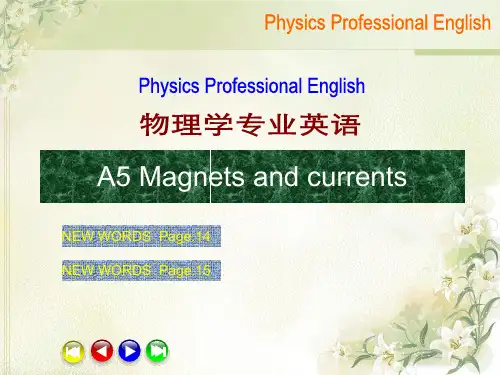
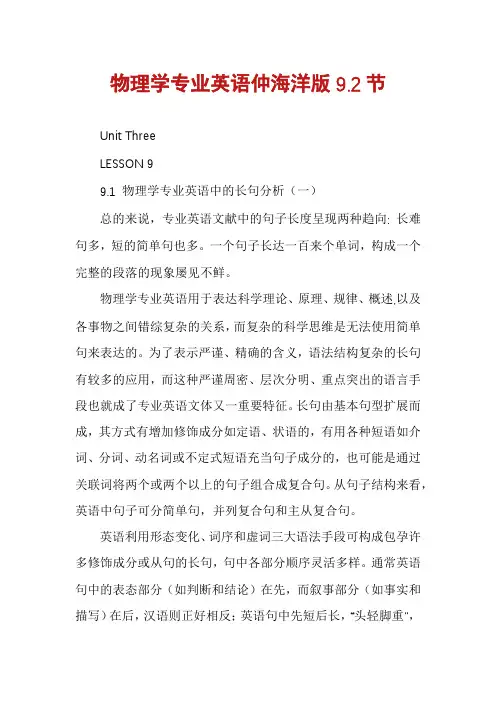
物理学专业英语仲海洋版9.2节Unit ThreeLESSON 99.1 物理学专业英语中的长句分析(一)总的来说,专业英语文献中的句子长度呈现两种趋向: 长难句多,短的简单句也多。
一个句子长达一百来个单词,构成一个完整的段落的现象屡见不鲜。
物理学专业英语用于表达科学理论、原理、规律、概述,以及各事物之间错综复杂的关系,而复杂的科学思维是无法使用简单句来表达的。
为了表示严谨、精确的含义,语法结构复杂的长句有较多的应用,而这种严谨周密、层次分明、重点突出的语言手段也就成了专业英语文体又一重要特征。
长句由基本句型扩展而成,其方式有增加修饰成分如定语、状语的,有用各种短语如介词、分词、动名词或不定式短语充当句子成分的,也可能是通过关联词将两个或两个以上的句子组合成复合句。
从句子结构来看,英语中句子可分简单句,并列复合句和主从复合句。
英语利用形态变化、词序和虚词三大语法手段可构成包孕许多修饰成分或从句的长句,句中各部分顺序灵活多样。
通常英语句中的表态部分(如判断和结论)在先,而叙事部分(如事实和描写)在后,汉语则正好相反;英语句中先短后长,“头轻脚重”,而汉语也正好相反;英语借助形态变化和连接手段而将句中成分灵活排列,汉语则常按时间和逻辑顺序由先到后、由因到果、由假设到推论、由事实到结论这样排列。
在专业英语的学习中,长句的分析是一个非常重要的基础,无论是专业文献阅读、翻译还是严谨精确地写作,都要从长句分析开始。
长句分析既重要也有些难度。
然而,无论多长的句子、多么复杂的结构,它们都是由一些基本的成分组成的。
只要弄清英语原文的句法结构,找出整个句子的中心内容,理解各层意思,然后分析各层意思之间的逻辑关系,再按汉语的特点和方式表达就可以理解或译出原文了。
9.1.1 长句结构的分析抓住主干,添枝加叶。
所谓抓住主干,就是在理解长句时首先要找到主语、谓语这两个主要成分。
添枝加叶,就是在主语、谓语这两个主要成分的基础上,逐个加上各种修饰语,包括定语、状语、补语、非谓语动词结构、各种从句等。

1、vectors矢量:velocity(速度v)acceleration(加速度a)force(力f)displacement(位移),Vectors(向量)2、scalars标量:speed(速率)weight(重量)mass(质量)volume(体积)energy(能量)work(功)3、The unit of SI(国际标准单位):metre米,kilogram千克KG,second秒S,newton牛顿N,watt瓦特W,ampere安培A,joule焦耳J4、连线:length长度----metre(M米),mass质量----kilogram(KG千克),time时间----second(S秒),current电流----ampere(A安培),temperature温度----kelvin(K开尔文),amount物质的量----mole(MOL摩尔),charge电荷----coulomb(C库伦),force力----neton(N牛顿),energy能量----joule(J焦耳),resistance电阻----ohm(Ω欧姆)5、(√×)Average velocity is not necessarily the same as average speed.平均速度不等于平均速率。
6、概念Displacement位移is distance moved in a particular direction. metre (m).7、用点,他们的组合效果被称为合力。
8、The turning effect of a force is called a moment(力矩)9、On earth, everything feels the downward force of gravity。
This gravitational force is called weight.(重力)10、Near the Ether’s surface, the gravitational force on each kg is about 10 N:the gravitational field strength重力场强度is 10 N kg-1. This is represented by the symbol g.(g的概念)11、Work功is done whenever a force makes something move.12、Things have energy能if they can do work。
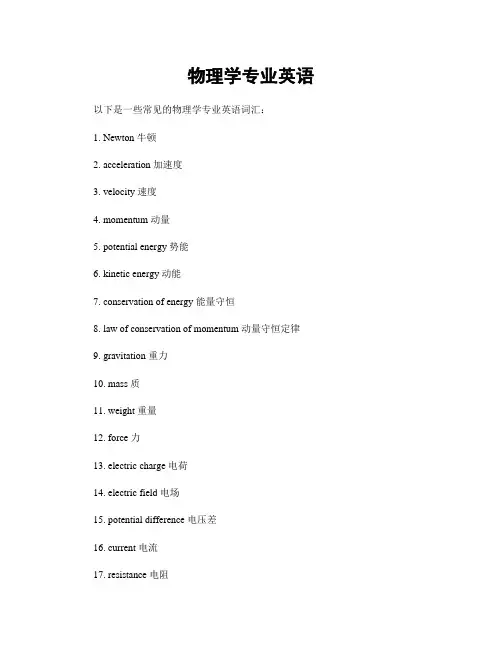
物理学专业英语以下是一些常见的物理学专业英语词汇:1. Newton 牛顿2. acceleration 加速度3. velocity 速度4. momentum 动量5. potential energy 势能6. kinetic energy 动能7. conservation of energy 能量守恒8. law of conservation of momentum 动量守恒定律9. gravitation 重力10. mass 质11. weight 重量12. force 力13. electric charge 电荷14. electric field 电场15. potential difference 电压差16. current 电流17. resistance 电阻18. voltage 电压19. capacitance 电容20. inductance 电感21. quantum mechanics 量子力学22. special relativity 狭义相对论23. general relativity 广义相对论24. elementary particles 基本粒子25. Higgs boson 希格斯玻色子26. antimatter反物质27. virtual particles 虚粒子28. uncertainty principle 不确定性原理29. wave-particle duality 波粒二象性30. quantum entanglement 量子纠缠31. classical mechanics 经典力学32. statistical mechanics 统计力学33. thermodynamics 热力学34. fluid mechanics 流体力学35. optics 光学36. acoustics 声学37. electromagnetism 电磁学38. weak interaction 弱相互作用39. strong interaction 强相互作用40. quantum chromodynamics 量子色动力学。
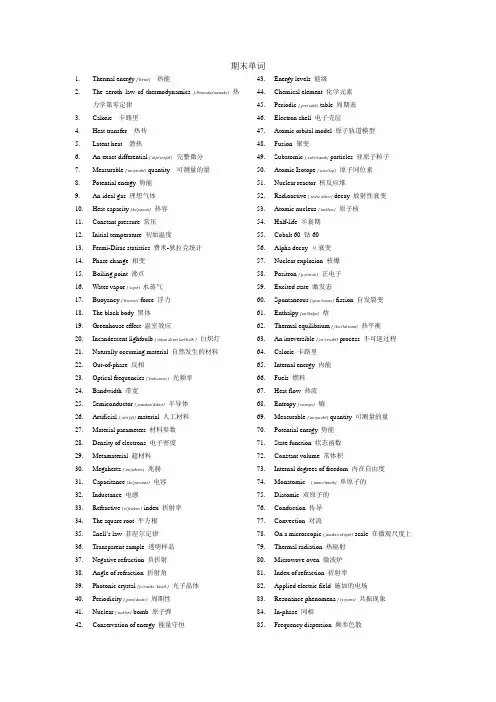
期末单词1.Thermal energy ['θɝml]热能2.The zeroth law of thermodynamics [,θɝmodaɪ'næmɪks]热力学第零定律3.Calorie 卡路里4.Heat transfer 热传tent heat 潜热6.An exact differential ['dɪfə'rɛnʃəl] 完整微分7.Measurable ['mɛʒərəbl] quantity 可测量的量8.Potential energ y 势能9.An ideal gas 理想气体10.Heat capacity [kə'pæsəti]热容11.Constant pressure 常压12.Initial temperatu re 初始温度13.Fermi-Dirac statistics 费米-狄拉克统计14.Phase change 相变15.Boiling point 沸点16.Water vapor ['vepɚ] 水蒸气17.Buoyancy ['bɔɪənsi] force 浮力18.The black bod y 黑体19.Greenhouse effect 温室效应20.Incandescent lightbulb ['ɪnkən'dɛsnt laɪt'bʌlb ]白炽灯21.Naturally occurring material 自然发生的材料22.Out-of-phase 反相23.Optical frequencies ['frikwənsiz]光频率24.Bandwidth 带宽25.Semiconductor [,sɛmɪkən'dʌktɚ]半导体26.Artificial [,ɑrtɪ'fɪʃl] material 人工材料27.Material parameters 材料参数28.Density of electrons 电子密度29.Metamaterial 超材料30.Megahertz ['mɛɡəhɝts]兆赫31.Capacitance [kə'pæsətns]电容32.Inductance 电感33.Refractive [rɪ'fræktɪv] index 折射率34.The square root 平方根35.Snell’s law 菲涅尔定律36.Transparent sample 透明样品37.Negative refraction 负折射38.Angle of refraction 折射角39.Photonic crystal [f o'tɑnɪks 'krɪstl ]光子晶体40.Periodicity [,pɪrɪə'dɪsəti]周期性41.Nuclear ['nuklɪɚ] bomb 原子弹42.Conservation of energy 能量守恒43.Energy levels 能级44.Chemical element 化学元素45.Periodic [,pɪrɪ'ɑdɪk] table 周期表46.Electron shell 电子壳层47.Atomic orbital model 原子轨道模型48.Fusion 聚变49.Subatomic [,sʌbə'tɑmɪk] particles 亚原子粒子50.Atomic Isotope ['aɪsə'top]原子同位素51.Nuclear reactor 核反应堆52.Radioactive ['redɪo'æktɪv] decay 放射性衰变53.Atomic nucleus ['nuklɪəs]原子核54.Half-life 半衰期55.Cobalt 60 钴6056.Alpha decay α衰变57.Nuclear explosion 核爆58.Positron ['pɑzɪtrɑn]正电子59.Excited state 激发态60.Spontaneous [spɑn'tenɪəs] fission 自发裂变61.Enthalpy [en'θælpɪ]焓62.Thermal equilibrium [,ikwɪ'lɪbrɪəm]热平衡63.An irreversible [,ɪrɪ'vɝsəbl] process 不可逆过程64.Calorie 卡路里65.Internal energy 内能66.Fuels 燃料67.Heat flow 热流68.Entropy ['ɛntrəpi]熵69.Measurable ['mɛʒərəbl] quantity 可测量的量70.Potential energ y 势能71.State function 状态函数72.Constant volume 常体积73.Internal degrees of freedom 内在自由度74.Monatomic [,mɒnə'tɒmɪk]单原子的75.Diatomic 双原子的76.Conduction 传导77.Convection 对流78.On a microscopic [,maɪkrə'skɑpɪk] scale 在微观尺度上79.Thermal radiation 热辐射80.Microwave oven 微波炉81.Index of refraction 折射率82.Applied electric field 施加的电场83.Resonance phenomena ['rɛznəns]共振现象84.In-phase 同相85.Frequency dispersion 频率色散86.Waveleng th 波长87.Miniature circuit ['mɪnətʃɚ 'sɝkɪt]微型电路88.Electromotive [ɪ,lɛktrə'motɪv] force 电动力plex number 复数90.Imaginary part 虚部91.Reversal [rɪ'vɝsl] of refraction 折射的反转92.The direction of incidence 入射方向93.Counterintuitive [,kaʊntərɪn'tʊɪtɪv; ,kaʊntərɪn'tjʊɪtɪv]发直觉的94.Boeing Phantom W orks 波音幻影工厂95.Detector 探测器96. A periodic structure 周期结构97.Electrical engineering电子工程98.Microwave circuit 微波电路99.Resonator 共振器100.Materials physics 材料物理101.Electronic configuration 电子排布102.Neutral atom 中性原子103.An experimental observation 实验观察104. A theoretical explanation 理论解释105.Bohr atom model 玻尔原子模型106.Spectroscopy [spɛk'trɑskəpi]波谱学107.Collision [kə'lɪʒən] process 碰撞过程108.Fission 裂变109.Electrical charge 电荷110.Optical microscope 光学显微镜111.Atomic number 原子数112.Interchangeable 可交换的113.Radioactivity 放射性114.Neutron ['nʊtrɑn]中子115.Proton ['protɑn]质子116.Radiation cancer therapy 放射癌症疗法117.Uranium [jʊ'renɪəm]镭118.Beta decay β衰变119.Gamma rays γ射线120.Genetic mu tation 基因变异期中单词1.Classical mechanics 经典力学2.Wave-particle duality 波粒二象性3.General relativity广义相对论4.Special relativity 狭义相对论5.Universal gravitation 万有引力6.Ellipse [ɪ'lɪps]椭圆7.An inclined plane 斜面8.The law of inertia [ɪ'nɝʃə]惯性定律9.The law of acceleration [ək'sɛlə'reʃən]加速度定律10.The law of action and reaction作用力反作用力定律11.Conservation of momentum [mo'mɛntəm]动量守恒12.Angular momentu m 角动量13.Theoretical explanation 理论解释14.Geometric optics 几何光学15.Corpuscular[kɔr'pʌskjəlɚ] theory 微粒说16.Forces applied 施力17.Degree of freed om 自由度18.Structure of space 空间结构19.Coordinate system 坐标系统20.Frame of reference 参照系21.Inertial frame 惯性系22.Non-inertial reference frame非惯性参考系23.Special position 特殊位置24.Relativistic mechanics 相对论力学25. A fundamental postulate 一个基本假设26.Ordinary differential equation 常微分方程27.Friction 摩擦力28.Initial velocity 初始速度29.Kinetic energy 动能30.Potential energ y 势能31.Conservation of energy 能量守恒32.Gravity force 重力33.Scalar ['skeilə; -lɑ:] product 标量积34.Line integral 线积分35.Conservative force 保守力36.Work-energy theorem 功能定理37.Current-carrying wire 载流线38.Statistical mechanics 统计力学39.Geometric optics 几何光学40.Direct current 直流41.Spring constant 弹簧常数42.Angular acceleration 角加速度43.Deceleration 减速44.Electromagnetism [i,lektrəu'mæɡniti zəm]电磁学45.Fundamental interaction 基本相互作用46.Electric field 电场47.Magnetic field 磁场48.Electrically charged particles 荷电粒子49.Electromagnetic induction 电磁感应50.Electric potential 电势51.Photon 光子52.Electricity and magnetism 电和磁53.Negative charges 负电荷54.Unlike charges 异性电荷55.Electrod ynamics 电动力学56.V isible light 可见光57.Gamma ray γ射线58.Attraction and repulsion 吸引和排斥59.Accurate theory 准确的理论60.Electromagnetic nature of light 光的电磁本性61.Maxwell’s equations 麦克斯韦方程62.Theoretical physics 理论物理63.Quantum effect 量子效应64.Speed of light 光速65.Electrical permittivity [,pɝmɪ'tɪvəti]介电常数66.Magnetic permeability 磁导率67.Photoelectric effect 光电效应68.Ultraviolet 紫外的69.Black b ody radiation 黑体辐射70.Quantum mechanics 量子力学71.Partial differential equation 偏微分方程72.Faraday’s law of induction 法拉第感应定律73.Magnetic [mæg'nɛtɪk] monopole ['mɑnə,pol]磁单极74.Dipole 偶极75.V ector field矢量场76.Electric generator 发电机77.Electromagnetic wave equation 电磁波动方程78.Electromagnetic radiation 电磁辐射79.Interferometer [,ɪntɚfɪ'rɑmətɚ] 干涉仪80.Lorentz transformation 洛伦兹变换81.Absolute reference frame 绝对参考系82.Inertial frame of reference 惯性参考系83.The principle of relativity 相对性原理84.Stationary system 静止系统85.Isotropy [ai'sɔtrəpi] 各向同性86.Homogeneity [,hɑmədʒə'niəti]均匀,同质性87.Light-speed invariance 光速不变88.Limiting speed 极限速度89.Mass-energy equivalence 质能等价性90.Conservation law 守恒定律91.Massless 无质量的92.Problematic ['prɑblə'mætɪk] 有问题的93.Elastic[ɪ'læstɪk]弹性94.Absolute state of rest绝对静止的状态95.Time dilation [dɪ'leʃən]时间膨胀96.Relative speed 相对速度position of velocities [və'lɑsətiz]速度合成98.Relativity of simultaneity 同时的相对性99.Lorentz contraction 洛仑兹收缩100.Three dimensions 三维。
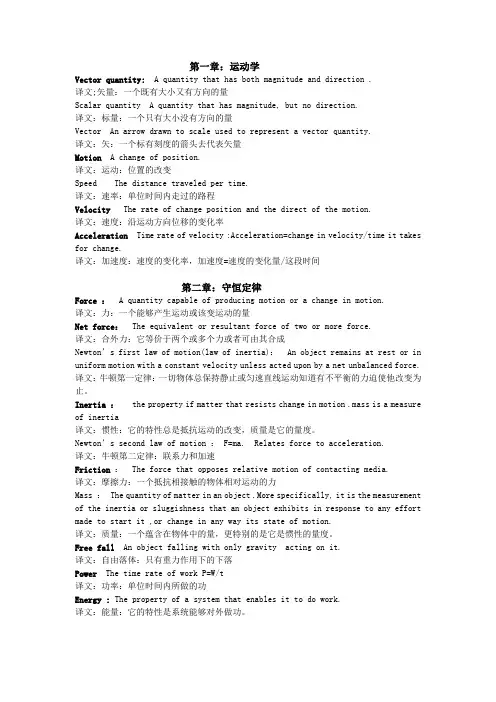
第一章:运动学Vector quantity: A quantity that has both magnitude and direction .译文;矢量:一个既有大小又有方向的量Scalar quantity A quantity that has magnitude, but no direction.译文:标量:一个只有大小没有方向的量Vector An arrow drawn to scale used to represent a vector quantity.译文:矢:一个标有刻度的箭头去代表矢量Motion A change of position.译文:运动:位置的改变Speed The distance traveled per time.译文:速率:单位时间内走过的路程Velocity The rate of change position and the direct of the motion.译文:速度:沿运动方向位移的变化率Acceleration Time rate of velocity :Acceleration=change in velocity/time it takes for change.译文:加速度:速度的变化率,加速度=速度的变化量/这段时间第二章:守恒定律Force : A quantity capable of producing motion or a change in motion.译文:力:一个能够产生运动或该变运动的量Net force: The equivalent or resultant force of two or more force.译文:合外力:它等价于两个或多个力或者可由其合成Newton’s first law of motion(law of inertia): An object remains at rest or in uniform motion with a constant velocity unless acted upon by a net unbalanced force.译文:牛顿第一定律:一切物体总保持静止或匀速直线运动知道有不平衡的力迫使他改变为止。
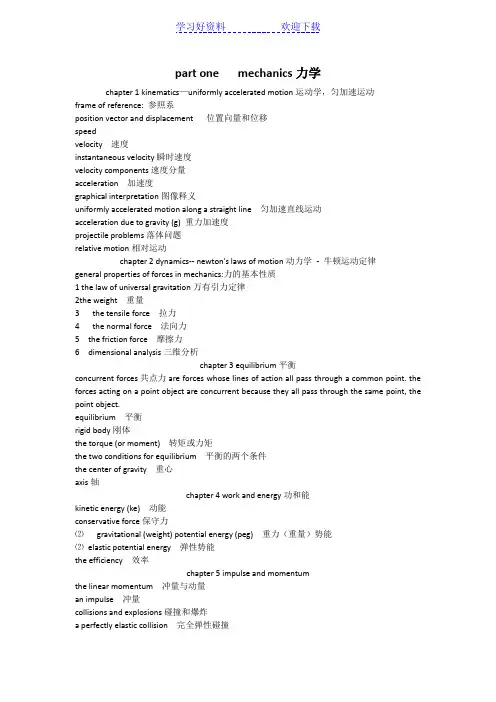
part one mechanics力学chapter 1 kinematics—uniformly accelerated motion运动学,匀加速运动frame of reference: 参照系position vector and displacement 位置向量和位移speedvelocity 速度instantaneous velocity瞬时速度velocity components速度分量acceleration 加速度graphical interpretation图像释义uniformly accelerated motion along a straight line 匀加速直线运动acceleration due to gravity (g) 重力加速度projectile problems落体问题relative motion相对运动chapter 2 dynamics-- newton's laws of motion动力学- 牛顿运动定律general properties of forces in mechanics:力的基本性质1 the law of universal gravitation万有引力定律2the weight 重量3 the tensile force 拉力4 the normal force 法向力5 the friction force 摩擦力6 dimensional analysis三维分析chapter 3 equilibrium平衡concurrent forces共点力are forces whose lines of action all pass through a common point. the forces acting on a point object are concurrent because they all pass through the same point, the point object.equilibrium 平衡rigid body刚体the torque (or moment) 转矩或力矩the two conditions for equilibrium 平衡的两个条件the center of gravity 重心axis轴chapter 4 work and energy功和能kinetic energy (ke) 动能conservative force保守力⑵gravitational (weight) potential energy (peg) 重力(重量)势能⑵elastic potential energy 弹性势能the efficiency 效率chapter 5 impulse and momentumthe linear momentum 冲量与动量an impulse 冲量collisions and explosions碰撞和爆炸a perfectly elastic collision 完全弹性碰撞coefficient of restitution恢复系数the center of mass重心chapter 6 rotation转动the angular speed 角速度the angular acceleration 角加速度tangential 【数】切线;正切centripetal acceleration ( )加速度the centripetal force 向心力chapter 7 rigid-body rotation刚体转动the moment of inertia 转动惯量parallel-axis theorem平行轴定理chapter 8 elasticity弹性elasticity弹性;弹力the stress 【物】应力[u][c]strain 应变the elastic limit弹性极限the shear modulus 切变模量standard atmospheric pressure标准大气压the hydrostatic pressure静水压力equation of continuity连续性方程the viscosity 粘度spring弹簧a restoring force 恢复力simple harmonic motion 简谐运动vibratory motion 振动运动the period ( ) 【数】循环节;周期the frequency ( ) 频率the elastic potential energy 弹性势能the simple pendulum 单摆chapter 11 wave motion波动a propagating wave 波传播wave terminology波术语in-phase vibrations同相振动standing waves驻波conditions for resonance共振的条件longitudinal (compressional) waves 纵向(挤压)波chapter 12 sound声音the intensey (i)强度loudness 响度beats节拍doppler effect 多普勒效应interference effects 干扰效应part two thermodynamics热力学chapter 1 the kinetic theory of gases第1章气体动力学理论avogadro's number ( ) 阿伏伽德罗数()the root mean square speed根均方速度the absolute temperature绝对温度the mean free path (m.f.p.) 平均自由程(m.f.p.)the equipartition theorem of energy 能量均分定理ideal gas law理想气体定律heat 热the internal energy 内部能量an isobaric process is a process carried out at constant pressure. 等压过程是恒压进行的过程。
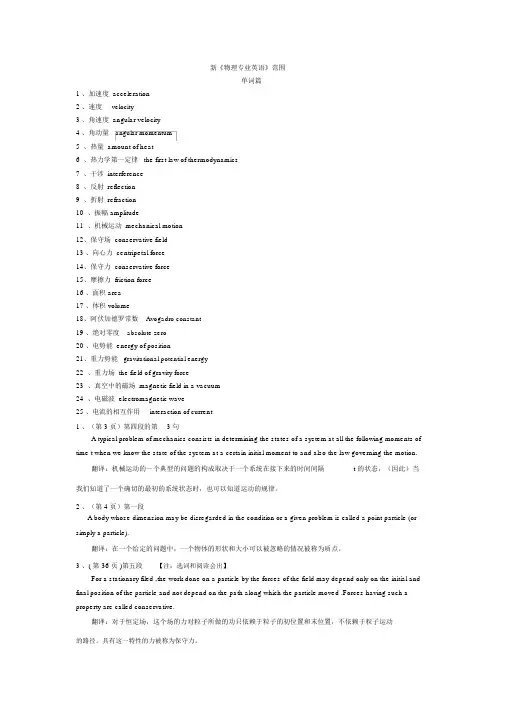
新《物理专业英语》范围单词篇1 、加速度 acceleration2 、速度velocity3 、角速度 angular velocity4 、角动量angular momentum5、热量 amount of heat6、热力学第一定律 the first law of thermodynamics7、干涉 interference8、反射 reflection9、折射 refraction10、振幅 amplitude11、机械运动 mechanical motion12、保守场 conservative field13 、向心力 centripetal force14、保守力 conservative force15、摩擦力 friction force16 、面积 area17 、体积 volume18、阿伏加德罗常数Avogadro constant19 、绝对零度absolute zero20 、电势能 energy of position21、重力势能gravitational potential energy22、重力场 the field of gravity force23、真空中的磁场 magnetic field in a vacuum24、电磁波 electromagnetic wave25 、电流的相互作用interaction of current1 、(第 3 页)第四段的第 3 句A typical problem of mechanics consists in determining the states of a system at all the following moments of time t when we know the state of the system at a certain initial moment to and also the law governing the motion.翻译:机械运动的一个典型的问题的构成取决于一个系统在接下来的时间间隔t 的状态,(因此)当我们知道了一个确切的最初的系统状态时,也可以知道运动的规律。

一、机械运动机械运动mechanical motion [mi'kænikəl] ['məuʃən]力学mechanics [mɪ'kænɪks]质点mass point [mæs] [pɔint]参考系reference frame ['refrəns] [freim]坐标系coordinate system [kəu'ɔ:dineit] ['sistəm]路程path[pɑ:θ]位移displacement[dɪs'pleɪsmənt]矢量vector['vektə]标量scalar['skeilə]速度velocity[vi'lɔsiti]平均速度average velocity['ævəridʒ] [vi'lɔsiti瞬时速度instantaneous velocity[,ɪnstən'teinjəs]速率speed[spi:d]v-t 图象v-t graph[ɡrɑ:f]加速度acceleration [æk,selə'reɪʃən]匀变速直线运动uniform variable rectilinear motion['ju:nifɔ:m] ['vɛəriəbl] [,rekti'liniə]初速度initial velocity[i'niʃəl] [vi'lɔsiti]自由落体运动free-fall motion自由落体加速free-fall acceleration[æk,selə'reɪʃən]重力加速度gravitational acceleration [,ɡrævi'teiʃnəl]二、物体的相互作用力force[fɔ:s]牛顿Newton['nju:tn]重力gravity['ɡræviti]重心center of gravity['sentə]万有引力gravitation[,grævɪ'teɪʃən]电磁相互electromagnetic interaction[ɪ,lektrəʊmæg'netɪk]强相互作用strong interaction[,ɪntər'ækʃən]弱相互作用weak interaction形变deformation[,di:fɔ:'meɪʃən,]弹性形变elastic deformation[i'læstik] [,di:fɔ:'meɪʃən,]弹性限度elastic limit[i'læstik] ['limit]弹力elastic force[i'læstik] [fɔ:s]劲度系数coefficient of stiffness[,kəʊə'fɪʃənt] ['stɪfnɪs]胡克定律Hooke law[lɔ:]摩擦力friction force['frikʃən]静摩擦力static frictional force['stætik] ['frikʃən]滑动摩擦力sliding frictional force['slaidiŋ]动摩擦因数dynamic friction factor[dai'næmik]合力resultant force[ri'zʌltənt]分力component force[kəm'pəunənt]力的合成composition of forces[,kɔmpə'ziʃən]平行四边形定则parallelogram rule[,pærə'lelə,græm]共点力concurrent forces[kən'kɜ:rənt,]力的分解resolution of force[,rezə'lu:ʃən]三角形定则triangular rule[traɪ'æŋgjələ] [ru:l]三、牛顿运动定律运动学kinematics[kini'mætiks]动力学dynamics[dai'næmiks]牛顿第一定律Newton first law['nju:tn] [lɔ:]惯性inertia [i'nə:ʃjə]惯性定律law of inertia[i'nə:ʃjə]质量mass[mæs]惯性系inertial system['sistəm]牛顿第二定律Newton second law单位制system of units国际单位制Le System International d’Unites作用力action['ækʃən]反作用力reaction[ri'ækʃən]牛顿第三定律Newton third law超重overweight[,əʊvə'weɪt]失重weightlessness['weɪtlɪs]误差error['erə]偶然误差accidental error[,æksi'dentl]系统误差systematic error [,sistə'mætik]绝对误差absolute error['æbsəlu:t]相对误差relative error['relətiv]四、圆周运动曲线运动curvilinear motion[kə:vi'liniə]切线tangent['tændʒənt]抛体运动projectile motion[prə'dʒektəl,]抛物线parabola[pə'ræbələ]线速度linear velocity['liniə]匀速圆周运动uniform circular motion['ju:nifɔ:m] ['sə:kjulə]角速度angular velocity['æŋgjələ]弧度radian['reidjən]周期period['piəriəd]向心加速度centripetal acceleration[sen'trɪpɪtl]向心力centripetal force[sen'trɪpɪtl]开普勒Kepler引力常量gravitational constant [,ɡrævi'teiʃnəl] ['kɔnstənt]万有引力定律law of universal gravitation[,ju:ni'və:səl]第一宇宙速度first cosmic velocity['kɔzmik]第二宇宙速度second cosmic velocity第三宇宙速度third cosmic velocity黑洞black hole五、能量能量energy['enədʒi]势能potential energy[pə'tenʃəl]动能kinetic energy[kɪ'netɪk, kaɪ-]功work[wə:k]焦耳joule[dʒu:l]功率power['pauə]瓦特watt['pauə]重力势能gravitational potential energy [,ɡrævi'teiʃnəl] [pə'tenʃəl]弹性势能elastic potential energy[i'læstik] [pə'tenʃəl]动能定理theorem of kinetic energy['θi:ərəm] [kɪ'netɪk]机械能mechanical energy[mi'kænikəl]机械能守恒定律law of conservation of mechanical energy[,kɔnsə'veiʃən] [mi'kænikəl]能量守恒定律law of energy conservation[,kɔnsə'veiʃən]拉力traction['trækʃən]轨道obital大小magnatitude方向direction[di'rekʃən]水平horizental竖直vertical['və:tikəl]相互垂直perpendicular[,pɜ:pən'dɪkjələ]坐标coordinate[kəu'ɔ:dineit]直角坐标系cersian coordinate system弹簧spring[spriŋ]球体sphere[sfiə]环loop[lu:p]盘型disc圆柱形cylinder['silində]。
分学科词汇物理类8.PHYSICS物理physics 物理mechanics 力学thermodynamics 热力学acoustics 声学electromagnetism 电磁学optics 光学dynamics 动力学force 力velocity 速度acceleration 加速度equilibrium 平衡statics 静力学motion 运动inertia 惯性gravitation 引力relativity 相对gravity 地心引力vibration 震动medium (media) 媒质frequency 频率wavelength 波长pitch 音高intensity 强度echo 回声resonance 回声,洪亮sonar 声纳ultrasonics 超声学electricity 电static electricity 静电magnetism 磁性,磁力magnet 磁体electromagnet 电磁magnetic field 磁场electric current 电流direct current (DC) 直流电alternating current (AC) 交流电electric circuit 电路electric charge 电荷electric voltage 电压electric shock 触电electric appliance 电器conductor 导体insulator 绝缘体semiconductor 半导体battery (cell) 电池dry battery 干电池storage battery 蓄电池electronics 电子学electronic 电子的electronic component (part) 电子零件integrated circuit 集成电路chip 集成电器片,集成块electron tube 电子管vacuum tube 真空管transistor 晶体管amplification (名词)放大amplify (动词)放大amplifier 放大器,扬声器oscillation 震荡optical 光(学)的optical fiber 光学纤维lens 透镜,镜片convex 凸透镜concave 凹透镜microscope 显微镜telescope 望远镜magnifier 放大镜spectrum 光谱ultraviolet 紫外线X rays X射线Gamma rays γ射线infrared rays 红外线microwaves 微波dispersion 色散transparent 透明translucent 半透明opaque 不透明的。
Aa.c. generator 交流发电机aberration 光行差,像差absolute index of refraction 绝对折射率absolute refractive index 绝对折射率absolute temperature scale 绝对温标absolute zero 绝对零度absorber 吸收体absorbing power 吸收能力,吸收本领absorptance 吸收比absorption 吸收absorption coefficient 吸收系数absorption line 吸收谱线absorption spectrum 吸收光谱,吸收谱accelerate 加速acceleration 加速度acceleration due to gravity 重力加速度acceleration-time graph 加速度—时间关系线图accelerator 加速器acceptor 接受体acceptor doping 受体掺杂acceptor impurity 受体杂质accommodation 调节,视觉调节accumulator 蓄电池accuracy 准确度acetate strip 醋酸酯条片achromatic 消色差的achromatic aberration 消色差achromatic condenser 消色差聚光透镜achromatic light 消色差光,白光acoustic blur 声响模糊acoustic board 吸音板,吸声板acoustic navigation 声响导航acoustic pressure 声压acoustics 声学act on 施于action 作用量,作用,作用力action of point 尖端作用activation 激活,活化activation energy 激活能,活化能active nucleus 活性核,放射性核activity 放射强度,放射性adapter 接合器adder 加法器adhesion 附着力,附着,黏附adhesive force 附着力adiabatic 绝热的adiabatic expansion 绝热膨胀adiabatic process 绝热过程aerial 天线aerial induction 天线调谐电感aerial network 天线网络aerodynamic force 气动力,空气动力aerodynamics 气体动力学,空气动力学aerofoil 机翼agent 剂air blower 吹风器air column 空气柱,气柱air cushion 气垫air damping 空气阻尼air film 气膜air track 气垫导航air wedge 气楔alignment 对准,校整alpha decay α衰变alpha part icle α粒子alpha particle scattering analogue α粒子放射模拟alternating current 交流电alternating voltage 交变电压,交流电压alternator 交流发电机altimeter 高度计,测高仪ammeter 安培计amorphous 非结晶的,无定形的ampere 安培,安ampere-hour 安培小时,安时amplification 放大,放大率amplifier 放大器amplify 放大amplitude 振幅amplitude modulation 调幅,振幅调剂amyl acetate 醋酸戊酯anaemia 贫血analogue 模拟analogue experiment 模拟实验analogue signal 仿真讯号,非数字讯号analogue-to-digital conversion 模拟转换analyser 检偏振器AND gate 「与」门anemometer 风速计aneroid barometer 无液气压计,空盒气压计angle of contact 接触角angle of deviation 偏向角angle of diffraction 衍射角,绕射角angle of dip 倾角angle of elevation 仰角angle of emergence 出射角angle of incidence 入射角angle of inclination 倾角angle of minimum deviation 最小偏向角angle of projection 投射角angle of reflection 反射角angle of refraction 折射角angle of twist 扭转角angstrom 埃angular acceleration 角加速度angular aperture 孔径张角angular displacement 角位移angular frequency 角频率angular impulse 角冲量angular magnification 角度放大,角放大率angular momentum 角动量,动量矩angular motion 角向运动,角运动angular seed 角速率angular velocity 角速度angular width 角宽度annealing 退火,韧化anode 阳极,正极anomalous expansion 反常膨胀antenna 天线anticlockwise moment 逆时针力矩antifreeze 防冻剂antinodal line 腹线antinode 波腹antiparticle 反粒子antiphase 反相,逆相aperture 孔径,口径,孔apparent depth 视深apparent expansion 表观膨胀,视膨胀apparent frequency 表观频率,视频率apparent loss in weight 表观失重apparent weight 表观重量Appleton layer 阿普顿层,F 电离层aqueous layer 水层Archimedes' principle 阿基米得原理area 面积argon 氩armature 电枢artificial disintegration 人工蜕变artificial radioactivity 人工放射astable 非稳态的astable circuit 非稳态电路astable multivibrator 非态多谐振荡器astigmatism 像散,散光astronomical telescope 天文望远镜at infinity 在无穷远处at rest 静止atmosphere 大气,大气层,大气压atmospheric pressure 大气压强atom 原子atomic bomb 原子弹atomic bond 原子键atomic density 原子密度atomic diameter 原子直径atomic energy 原子能atomic mass 原子质量atomic mass unit 原子质量单位atomic model 原子模型atomic nucleus 原子核atomic number 原子序数atomic radius 原子半径atomic separation 原子间距atomic spacing 原子间距atomic structure 原子结构atomic theory 原子论atomizer 喷雾器attenuation 衰减attraction 吸引attractive force 吸力audible frequency range 听频范围audible signal 可听讯号audio frequency 声频autofocus 自动聚焦,自动对焦avalanche 电子雪崩average acceleration 平均加速度average power 平均功率average speed 平均速率average velocity 平均速度Avogadro constant 阿佛加德罗常数,阿佛加德罗常量Avogadro number 阿佛加德罗数Avogadro's law 阿佛加德罗定律axial 轴向的,沿轴的axial field 轴向场axial search coil 轴向探察线图axis 轴axis of rotation 转轴Bback e.m.f. 反电动势background radiation 本底辐射Bainbridge mass spectrometer 班布里奇质谱仪balance 天平,秤,平衡balance arm 秤杆,平衡臂balance point 平衡点balance bridge 平衡电桥balanced force 平衡力ball bearing 球轴承,滚珠轴承ballistic galvanometer 冲击电流计,冲击检流计ballistic pendulum 冲击摆Balmer series 巴耳末系,巴耳末光谱band spectrum 带状光谱,带状谱bandwidth 带宽bar code 条形码bar magnet 磁棒bare wire 裸线barium 钡barometer 气压计barrier 障碍物barrier layer 阻档层,耗尽层barrier potential difference 阻档层电势差,阻档层电位差Barton's pendulums 巴尔通摆base 基极base current 基极电流battery 电池组battery charger 电池充电器battery holder 电池座beaker 烧杯beam splitter 分束器,射束分离器beat 拍beat frequency 拍频becquerel 贝克勒耳,贝克bel 贝尔,贝bell jar 钟形罩bench mat 实验台垫Bernoulli's theorem 伯努利定律beryllium 铍beta decay β衰变beta particle β粒子biasing circuit 偏压电路biasing voltage 偏压biconcave lens 双凹透镜biconvex lens 双凸透镜bicycle dynamo 自行车发电机,脚踏车发电机bifilar pendulum 双线摆bifocal lens 双焦距透镜big bang model 大爆炸模型bimetallic strip 双层金属片,双金属片binary adder 二进加法器binary system 二进制binding 结合binding energy 结合能binoculars 双筒望远镜Biot-Savart law 毕奥—萨伐尔定律bipolar 双极的birefraction 双折射bistable 双稳态的,双稳器bistable circuit 双稳电路bistable multivibrator 双稳态多谐振荡器bit 二进制制,位black body radiation 黑体辐射block and tackle 滑轮组block diagram 方框图blocking capacitor 隔直流电器容blooming 敷霜,表面加膜Bohr atom 玻尔原子Bohr radius 玻尔半径Bohr theory 玻尔理论boil 沸腾,煮沸boiler 锅炉boiling point 沸点bolometer 辐射热计Boltzmann constant 玻耳兹曼常数,玻耳兹曼常量bombardment 轰击bond energy 键能bonding 键合Bourdon gauge 布尔登气压计bow wave 弓形波,舷波Boyle's law 博伊尔定律Brackett series 布喇开系,布喇开光谱Bragg angle 布喇格角Bragg diffraction 布喇格衍射,布喇格绕射Bragg plane 布喇格平面Bragg's law 布喇格定律brake 制动器breakdown potential 击穿电势,击穿电位breaking point 断点breaking strength 抗断强度breaking stress 致断应力breeder reactor 增殖反应堆bremsstrahlung 轫致辐射Brewster's law 布鲁斯特定律bridge circuit 桥式电路bridge rectifier 桥式整流器bright fringe 亮纹brightness 亮度brittle 脆的,易碎的bromine 溴Brownian movement 布朗运动brush 电刷bubble chamber 气泡室bubble raft model 泡筏模型buffer 缓冲器buffer circuit 缓冲电路bulk modulus 体积弹性模量Bunsen burner 本生灯buoyancy 浮力burette 滴定管burette stand 滴定管架burglar alarm 防盗警报器,防盗警钟buzzer 蜂鸣器by-pass 旁路byte 二进制组,字节cable 电缆cadmium sulphide 硫化镉caesium 铯calcite 方解石calibrate 校准,标上刻度calipers 测径器,卡钳calorie 卡路里,卡calorimeter 量热器camera 照相机cancer cell 癌细胞candela 坎德拉cantilever 悬臂capacitance 电容capacitance substitution box 换值电容箱capacitive circuit 电容电路capacitive component 电容性分量capacitive coupling 电容耦合capacitive discharge 电容性放电capacitive reactance 容抗capacitor 电容器capacitor-input filter 电容输入滤波器capacity 容量,载量capillarity 毛细现象,毛细作用capillary depression 毛细下降capillary rise 毛细上升capillary tube 毛细管capsule 囊capture 俘获carbon 碳carbon granule 碳颗粒carbon paper disc 圆形碳纸carbon-14 dating 碳14 年代测定法carburettor 化油器,汽化器carrier wave 载波carry 进位castor oil 蓖麻油cathode 阴极,负极cathode ray 阴极射线cathode ray deflection tube 阴极射线偏转管cathode-ray oscilloscope 阴极射线示波器,示波器cathode-ray tube 阴极射线管cavity resonator 空腔共振器celestial telescope 天体望远镜cell 电池,细胞Celsius temperature scale 摄氏温标centimetre 厘米centralized low voltage power supply unit 中央控制低压电源箱centre of curvature 曲率中心centre of gravity 重心centre of mass 质心centre of oscillation 振荡中心centre-tapped transformer 中心抽头变压器centrifugal force 离心力centrifuge 离心机centripetal acceleration 向心加速度centripetal force 向心力Chadwick 查德威克chain reaction 连锁反应change of state 物态变化change-over switch 换向开关characteristic 特性,特征characteristic curve 特性曲线characteristic line 特征线,特征谱characteristic spectrum 特征光谱,特征谱charge 电荷,充电,起电charge carrier 载荷子charge conservation 电荷守恒charge density 电荷密度charge distribution 电荷分布charge to mass ratio 荷质比charged particle 带电粒子charging by contact 接触起电charging by friction 摩擦生电charging by induction 感应起电charging by sharing 授受起电charging time constant 充电时间常数,充电时间常量Charles's law 查理定律choke 扼流,抗流,扼流圈,抗流圈choke circuit 扼流电路,抗流电路chromatic aberration 色差chromatic dispersion 色散cinefilm soundtrack 电影胶片声迹circle of least confusion 最少模糊圈,明晰圈circuit 电路circuit board 电路板circuit breaker 断路器circuit symbol 电路符号circular coil 环形线圈circular motion 圆周运动circular orbit 圆周轨道circular pulse 圆形脉冲circular wave 圆形波circular wavefront 圆形波阵面,圆形波前clamp 夹钳,夹紧clap-echo method 「拍掌—回声」法cleave 裂开clinical thermometer 体温计clip 夹子clockwise moment 顺时针力矩closed circuit 闭合电路closed pipe 闭管closed tube 闭管closed-loop control system 死循环控制系统closed-loop gain 死循环增益closed-loop voltage gain 死循环电压增益closely packed 密堆积的cloud chamber 云室cloud chamber track 云室径迹coaxial 共轴,同轴coaxial cable 同轴电缆,同轴cobalt 钴code 编码coder 编码器coefficient of dynamic friction 动摩擦系数coefficient of friction 摩擦系数coefficient of restitution 恢复系数coefficient of static friction 静摩擦系数coefficient of viscosity 黏滞系数coherent 相干的cohesion 内聚力,内聚cohesive force 内聚力coil 线圈collector 集电极,集极collector current 集电极电流,集极电流collimator 准直管,准直仪collision 碰撞colour 颜色colour code 色码,色标combinational logic 组合逻辑common emitter 共发射极common-mode voltage 共模电压commutator 换向器compass 指南针,罗盘complete circuit 完整电路component 组件,分量,组分component of force 分力compound microscope 复式显微镜compound pendulum 复摆compressed gas 压缩气体compressibility 可压缩性,压缩系数,压缩率compressible fluid 可压缩性流体compression 密部,压缩compression spring balance 压缩弹簧天平concave 凹concave lens 凹透镜concave mirror 凹镜,凹面镜concentric capacitor 同心电容器condensation 凝结,凝聚condensation nucleus 凝结核,凝聚核condensation point 凝点,凝结点condenser 聚光器,电容器,冷凝器conductance 电导conductivity 传导性,传导率conductor 导体conical pendulum 锥摆conjugate foci 共轭焦点conservation of angular momentum 角动量守恒conversation of charge 电荷守恒conservation of energy 能量守恒conservation of mechanical energy 机械能守恒conservation of momentum 动量守恒conservative force 守恒力,保守力conserved 守恒constant acceleration 恒加速度constant angular acceleration 恒角加速度constant angular velocity 恒角速度constant force 恒力constant motion 恒速运动constant pressure 定压constant speed 恒速率constant temperature 定温constant velocity 恒速度constant volume 定容constant volume gas thermometer 定容气体温度计constantan 康铜constriction 颈缩constructive interference 相长干涉contact angle 接触角contact area 接触面积contact force 接触力continuity equation 连续性方程continuous spectrum 连续光谱,连续谱continuous wave 连续波contract 收缩control experiment 对照实验,比对实验control grid 控制栅极control rod 控制棒control system 控制系统convection 对流converge 会聚converging lens 会聚透镜converging mirror 会聚镜convex 凸convex lens 凸透镜convex mirror 凸镜,凸面镜coolant 冷却剂cooling by evaporation 蒸发致冷cooling correction 冷却修正cooling curve 冷却曲线cooling effect 冷却效应cooling system 冷却系统,散热系统coplanar forces 共面力core 心,核心Coriolis force 科里奥利力corkscrew rule 螺旋法则cornea 角膜corona discharge 电晕放电corpuscular theory of light 光的微粒学说correction 矫正,修正cosmic radiation 宇宙辐射coulomb 库伦Coulomb's law 库伦定律count rate 计数率counter 计数器counter weight 平衡锤,配重couple 力偶coupled oscillation 耦合振荡coupling 耦合covalent bond 共价键crane magnet 起重磁铁creep 蠕变crest 波峰critical angle 临界角critical damping 临界阻尼critical mass 临界质量critical point 临界点critical temperature 临界温度critical velocity 临界速度crocodile clip 鳄鱼夹cross hairs 十字丝,叉丝cross-sectional area 截面积Crova's disc 克罗瓦盘crystal 晶体crystal diffraction 晶体衍射,晶体绕射crystal lattice 晶体点阵,晶体格子,晶格crystal planes 晶面crystalline 结晶的crystallization 结晶crystallography 晶体学cubical expansivity 体积膨胀系数,体积膨胀率curie 居里current 电流current amplification 电流放大current amplification factor 电流放大因素current amplifier 电流放大器current balance 电流天平current density 电流密度current gain 电流增益current intensity 电流强度current pulse 电流脉冲current sensitivity 电流灵敏度current stabilizer 稳流器current transfer characteristic 电流转移特性current-carrying conductor 载电流导体current-voltage characteristic curve 电流—电压特性曲线curved mirror 曲面镜cyclotron 回旋加速器cylindrical concave lens 柱面凹透镜cylindrical concave mirror 柱面凹镜cylindrical convex lens 柱面凸透镜cylindrical convex mirror 柱面凸镜cylindrical lens 柱面透镜cylindrical mirror 柱面镜Dd.c. generator 直流发电机d.c. motor 直流电动机Dalton's law of partial pressures 道尔顿分压定律damped harmonic motion 阻尼谐动damped harmonic oscillation 阻尼谐振damped oscillation 阻尼振荡damping 阻尼damping force 阻尼力dark fringe 暗纹data 数据dating 年代测定daughter nucleus 子核daughter nuclide 子核素de Broglie relation 德布罗意关系式de Broglie wave 德布罗意波dead time 失效时间decade capacitance box 十进电容箱decade resistance box 十进电阻箱decay 衰变decay analogue 衰变模拟decay constant 衰变常数,衰变常量decay curve 衰变曲线decay law 衰变定律decay product 衰变产物decelerate 减速deceleration 减速度decibel 分贝decode 译码,解碼decoder 译码器,译码器deflection 偏转deflection plate 偏转板deflection system 偏转系统deflection tube 偏转管deformation 形变degradation of energy 能量退降,能量递降degree 度degree Celsius 摄氏度degree of freedom 自由度demagnetization 去磁,退磁demonstration diode 演示用二极管demonstration meter 演示用电表density 密度depletion layer 耗尽层,阻挡层depth of field 景深derived quantity 导出量derived unit 导出单位destructive interference 相消干涉detection 探测detector 探测器detector of radiation 辐射探测器deuterium 氘,重氢deuteron 氘核,重氢核deviation 偏向,偏差device 装置,设计,器件diamagnetism 抗磁性diaphragm 光阑,膜片diatomic molecule 双原子分子dielectric 电介质,介电的dielectric constant 介电常数,介电常量,电容率dielectric polarization 电介质极化dielectric strength 电介质强度differential equation 微分方程differential input voltage 差动输入电压diffracted ray 衍射线,绕射线diffraction 衍射,绕射diffraction grating 衍射光栅,绕射光栅diffuse reflection 漫反射diffusion 扩散,漫射diffusion cloud chamber 扩散云室digital 数字的digital display 数字显示digital signal 数字讯号digital-to-analogue conversion 数模转换dimension 量纲,因次,维,大小dimensional analysis 量纲分析,因次分析diminished 缩小diode 二极管diode probe 二极管微波探测器dioptre 屈光度,焦度dipole 偶极子direct current 直流电direction 方向,方位direction of propagation 传播方向directly heated cathode 直热式阴极discharge 放电disintegration 蜕变dislocation 位错dispersion 色散dispersive power 色散能力,色散本领,色散率displacement 位移,排量displacement can 排水罐displacement-time graph 位移—时间关系线图dissipative force 耗散力distance 距离distance-time graph 距离—时间关系线图distortion 失真,扭曲,畸变disturbance 干扰diverge 发散diverging lens 发散透镜diverging mirror 发散镜division of amplitude 振幅分割division of wavefront 波阵面分割,波前分割domain 畴,域domestic circuit 家居电路donor 给予体doped semiconductor 掺杂半导体doping 掺杂Doppler broadening 多普勒谱线增宽Doppler effect 多普勒效应Doppler shift 多普勒频移dosage 剂量dose 剂量dose rate 剂量率double pulley 双滑轮double refraction 双折射double slit 双缝double-pole-double-throw switch 双刀双掷开关doublet 双重线drag force 阻力,曳力drift velocity 漂移速度driver circuit 驱动电路driver frequency 驱动频率driving cell 驱动电池driving force 驱动力driving mirror 行车后视镜dry battery 干电池组dry cell 干电池dual trace oscilloscope 双迹示波器ductile 延性的Dulong-Petit law 杜隆—珀替定律dynamic equilibrium 动态平衡dynamic friction 动摩擦dynamic resistance 动态电阻dynamics 动力学dynamo 发电机Eearth 接地,地线earthquake waves 地震波ebonite 硬橡胶,硬质胶ebonite rod 硬橡胶棒,硬质胶棒echo 回声,回波eddy current 涡电流,涡流eddy current damping 涡流阻尼eddy current loss 涡流损耗effective mass 有效质量efficiency 效率effort 施力Einstein's mass-energy relation 爱因斯坦质能关系式elastic collision 弹性碰撞elastic constant 弹性常数,弹性常量elastic deformation 弹性形变elastic hysteresis 弹性滞后elastic limit 弹性极限elastic strain energy 弹性应变能elasticity 弹性electric bell 电铃electric charge 电荷electric current 电流electric field 电场electric field intensity 电场强度electric field pattern 电场图形electric fire 电暖炉electric line of force 电力线electric motor 电动机electric potential 电势,电位electric power 电功率electric shock 电震electrical appliance 电器electrical conductivity 导电率electrical energy 电能electrical oscillation 电振荡electrical potential energy 电势能,电位能electrical resonance 电共振electricity 电,电学electrode 电极electrolysis 电解electrolyte 电解质electrolytic 电解质的,电解的electrolytic capacitor 电解质电容器electromagnet 电磁铁,电磁体electromagnetic coil 电磁感应圈electromagnetic contact 电磁触点electromagnetic force 电磁力electromagnetic induction 电磁感应electromagnetic moment 电磁矩electromagnetic oscillation 电磁振荡electromagnetic radiation 电磁辐射electromagnetic spectrum 电磁波谱electromagnetic wave 电磁波electromagnetism 电磁学electrometer 静电计electromotive force 电动势electron 电子electron beam 电子束electron cloud 电子云electron diffraction 电子衍射,电子绕射electron drift 电子漂移electron energy level 电子能级electron gun 电子枪electron transition 电子跃迁electron tube 电子管electron-volt 电子伏特,电子伏electronics 电子学electrophorus 起电盘electroscope 验电器electrostatic bond 静电键electrostatic field apparatus 静电场仪器electrostatic precipitation 静电沉淀法electrostatics 静电学element 元素,组件elliptic orbit 椭圆轨道elongation 伸长度emergent ray 出射线emission 发射emission line 发射谱线emission spectrum 发射光谱,发射谱emissivity 发射率,比辐射率emit 发射emitter 发射极,射极emitter current 发射极电流,射极电流enamelled wire 漆包线encode 编码encoder 编码器end-correction 端部修正,管口校正量end-on collision 同向碰撞,尾追碰撞energetic particle 高能粒子energy 能量,能energy band 能带energy conversion 能量转换energy conversion efficiency 能量转换效率energy input 能量输入energy level 能级energy output 能量输出energy transfer 能量转移enriched uranium 浓缩铀equation of continuity 连续性方程equation of state 物态方程equation of uniformly accelerated motion 匀加速运动方程equatorial orbit 赤道轨道equilibrium 平衡equilibrium condition 平衡条件equilibrium spacing 平衡间距equipartition of energy 能量均分equipotential 等势的,等位的equipotential line 等势线,等位线equipotential surface 等势面,等位面equivalent capacitance 等效电容equivalent inductance 等效电感equivalent resistance 等效电阻erect 正立escape velocity 逃逸速度ether 以太,醚evacuation 抽成真空evaporation 蒸发excess pressure 超压,逾电压excitation 激发excitation energy 激发能excitation potential 激发电势,激发电位excitation voltage 激发电压excited 受激excited energy level 受激能级excited state 受激态expansion 膨胀expansivity 膨胀系数,膨胀率exponential change 指数式改变exponential decay 指数式衰变exposure 曝光量,照射extension 伸长external force 外力external work 外功extra high tension 超高电压extra-nuclear structure 核外结构extraordinary ray 非常光线extrapolation 外推,外推法extrinsic semiconductor 含杂质半导体eyepiece 接目镜,目镜Ff-number f 数,光圈数f-stop f 制光圈far point 远点farad 法拉Faraday constant 法拉第常数,法拉第常量Faraday's law of electromagnetic induction 法拉第电磁感应定律fast breeder reactor 快中子增殖反应堆feedback 反馈feedback amplifier 反馈放大器feedback resistance 反馈电阻ferromagnetic substance 铁磁性物质ferromagnetism 铁磁性fictitious force 假力,伪力fidelity 保真性,保真度field coil 场线圈field effect transistor 场效应晶体管field intensity 场强field lines 场力线field magnet 场磁铁,场磁体field of view 视场,视野field strength 场强figure of merit 优值,灵敏值filament 灯丝,丝极filter capacitor 滤波电容器filter circuit 滤波电路filter pump 滤泵final state 终态,末态final velocity 末速度fine-adjustment 微调,细调fire alarm 火警警报器,火警钟first law of thermodynamics 热力学第一定律first order spectrum 第一级光谱,第一级谱fission 裂变fission reactor 裂变反应堆fixed point 定点fixed pulley 定滑轮fixed resistor 定值电阻器flat coil 扁平线圈flat solenoid 扁平螺线管flat-bottomed flask 平底烧瓶Fleming's left hand rule 弗林明左手定则Fleming's right hand rule 弗林明右手定则floating body 浮体fluid 流体fluid dynamics 流体动力学fluorescence 荧光fluorescent screen 荧光屏,荧光幕flux 通量flux density 通量密度fly-back 回扫flywheel 飞轮focal length 焦距focal plane 焦平面focus 焦点,聚焦,对焦focus control 聚焦控制follower circuit 跟随电路foot pump 脚踏泵force 力force constant 力常数,力常量force polygon 力多边形force resolution 力的分解force triangle 力三角形force-extension curve 施力—伸长关系曲线forced oscillation 受迫振荡former 框forward biased 正向偏压forward current 正向电流fossil fuel 化石燃料Foucault's rotating mirror method 傅科旋转镜法frame of reference 参考坐标系,参考系Franck-Hertz experiment 弗兰克—赫兹实验Fraunhofer diffraction 夫琅和费衍射,夫琅和费绕射Fraunhofer lines 夫琅和费谱线free electron 自由电子free fall 自由下坠,自由下落free falling body 自由落体free oscillation 自由振荡free path 自由程free space 自由空间freeze 凝固freezing point 凝固点freon 氟利昂,二氯二氟甲烷frequency 频率frequency modulation 调频,频率调制frequency response 频率响应Fresnel diffraction 菲涅耳衍射,菲涅耳绕射Fresnel's biprism 菲涅耳双棱镜friction 摩擦,摩擦力friction compensated 补偿摩擦作用frictionless motion 无摩擦运动fringe 条纹fringe pattern 条纹图形fuel rod 燃料棒fulcrum 支点full adder 全加法器full-scale deflection 满标偏转full-wave rectification 全波整流full-wave rectifier 全波整流器fundamental frequency 基频fundamental mode of vibration 基谐振动模式fundamental note 基音fundamental quantity 基本量fundamental unit 基本单位fuse 保险丝fuse rating 保险丝额定值fusion 熔解,聚变fusion point 熔点fusion reactor 聚变反应堆GG - clamp G-形钳gain 增益gain control 增益控制galaxy 星系Galilean telescope 伽利略望远镜Galileo's thought experiment 伽利略假想实验galvanometer 电流计,检流计gamma radiation 伽玛辐射gamma ray 伽玛射线gap 隙gas 气,气体gas pressure 气体强压,气压gaseous phase 气相gaseous state 气态gauge 规,计Gauss theorem 高斯定理Geiger counter 盖革计数器Geiger-Marsden scattering experiment 盖革—马斯登散射实验Geiger-Muller counter 盖革—弥勒计数器Geiger-Muller tube 盖革—弥勒管general gas equation 普适气体方程general gas law 普适气体定律generator 发电机genetic effect 遗传效应geometrical optics 几何光学germanium 锗ghost effect 迭影效应glancing angle 掠射角glass fibre 玻璃纤维glycerine 甘油gold foil 金箔fold leaf electroscope 金箔验电器gradient 斜率,梯度graduated cylinder 量筒Graham's law of diffusion 格拉哈姆散定律grain 粒,晶粒gramophone record 唱片,唱碟graph 图,线图,图表graphical method 图解法grating 光栅grating spectrometer 光栅光谱仪,光栅分光计gravitational acceleration 重力加速度gravitational attraction 引力,重力gravitational constant 引力常数,引力常量gravitational field 引力场,重力场gravitational force 引力,重力gravitational mass 引力质量gravitational potential 引力势,重力势gravitational potential difference 引力势差,重力势差gravitational potential energy 引力势能,重力势能gravity 重力grazing incidence 掠入射,切入射greenhouse effect 温室效应grid 栅极grid control 栅极控制grid system 电力网groove 纹道,针槽,开槽ground 接地ground state 基态guinea and feather experiment 「硬币与羽毛」实验Hhair spring 游丝half adder 半加法器half-life 半衰期half-silvered mirror 半镀银镜half-wave rectification 半波整流half-wave rectifier 半波整流器Hall effect 霍耳效应Hall probe 霍耳探测器Hall voltage 霍耳电压hand stroboscope 手动式频闪观测器harmonic 谐音harmonic motion 谐运动harmonic oscillation 谐振荡head-on collision 对正碰撞,正碰heat 热,热量,加热,热学heat absorbent 吸热剂heat absorber 吸热器heat absorption 吸热,热吸收heat capacity 热容量heat conduction 热传导heat exchange 热交换heat flow 热流heat gain 热增益,得热heat insulation 热绝缘,隔热heat loss 热损耗,失热heat proof 耐热的,隔热的heat pump 热泵heat radiation 热辐射heat reservoir 热库,储热器heat sink 热壑heat transfer 热传递,热转移heater 发热器,加热器heating effect 热效应heating element 发热组件Helmholtz coils 亥姆霍兹线圈henry 亨利,亨hertz 赫兹,赫high dispersion prism 高色散棱镜high tension 高电压hole 空穴,空子hollow plastic lens 空心塑料透镜hollow plastic prism 空心塑料棱镜hologram 全息图holography 全息术,全息学Hooke's law 虎克定律horizontal 水平horizontal component 水平分量horizontal deflection 水平偏转horseshoe magnet 蹄形磁铁hot cathode 热阴极hour 小时Huygens' principle 惠更斯原理hydraulic press 水压机hydroelectric power 水力发电hydrogen bomb 氢弹hygrometer 湿度计hyperbolic orbit 双曲线轨道hypodermic needle 皮下注射针头hypodermic syringe 皮下注射针筒hypothesis 假说,假设hysteresis 滞后现象ideal gas 理想气体ideal gas equation 理想气体方程ideal gas temperature scale 理想气体温标ideal machine 理想机械illuminate 照明,照亮image 像image distance 像距immerse 浸没immersion heater 浸没式电热器impact 碰撞impedance 阻抗impulse 冲量impurity 杂质in focus 焦点对准in parallel 并联in phase 同相in series 串联incident ray 入射线incident wavefront 入射波阵面,入射波前inclined plane 斜面incoherent 不相干的incompressible fluid 非压缩性流体indicator 指示器indirectly heated cathode 旁热式阴极induced charge 感生电荷induced current 感生电流induced e.m.f. 感生电动势induced voltage 感生电压inducing charge 施感电荷inducing current 施感电流inductance 电感inductance capacitance coupled circuit 感容耦合电路inductance coil 电感线圈induction 感应induction heating 感应生热inductive circuit 电感电路inductive component 电感性分量inductive reactance 感抗inductor 电感器,感应器inelastic collision 非弹性碰撞inert gas 惰性气体inertia 惯性,惯量inertia balance 惯性秤inertial frame 惯性坐标系,惯性系inertial mass 惯性质量infra-red detector 红外线探测器infra-red radiation 红外辐射infra-red ray 红外线initial state 初态initial velocity 初速度input 输入input bias current 输入偏压电流input characteristic 输入特性input current 输入电流input offset current 输入补偿电流input power 输入功率input resistance 输入电阻input voltage 输入电压input-output voltage characteristic 输入—输出电压特性instantaneous acceleration 瞬时加速度instantaneous angular velocity 瞬时角速度instantaneous current 瞬时电流instantaneous power 瞬时功率instantaneous speed 瞬时速率instantaneous velocity 瞬时速度instantaneous voltage 瞬时电压insulation 绝缘insulator 绝缘体integrated circuit 集成电路intensity 强度intensity control 强度控制intensity of current 电流强度interaction 相互作用interatomic force 原子间力interatomic potential 原子间势,原子间位interatomic separation 原子间距intercept 截距,截段interconversion 互换interference 干涉interference pattern 干涉图形internal energy 内能internal force 内力internal resistance 内电阻internal work 内功international system of units 国际单位制,公制,十进制interval 间隔intrinsic semiconductor 纯半导体,本征半导体inverse-square law 平方反比定律inverted 倒立的inverter 反相器,倒换器inverting input 反相输入ion 离子ion-pair 离子偶,离子对ionic bond 离子键ionic structure 离子结构ionization 电离作用ionization chamber 电离室ionization current 电离电流ionization energy 电离能ionization potential 电离电势,电离电位ionization voltage 电离电压ionize 电离ionized atom 离子ionized layer 电离层ionizing power 致电离能力,致电离本领ionizing radiation 致电离辐射ionosphere 电离层iris 虹膜,可变光阑iron core 铁心iron filings 铁粉irreversible process 不可逆过程isobar 等压线,同质异序素isobaric expansion 等压膨胀isobaric process 等压过程isochronous oscillation 等时振荡isotherm 等温线isothermal process 等温过程isotope 同位素isovolumetric process 等容过程JJaegers method 耶格法jet propulsion 喷气推进jockey 滑动触头joule 焦耳joulemeter 焦耳计junction 连接,接头junction diode 面结型二极管junction transistor 面结型晶体管KKaleidoscope 万花筒Kelvin 开尔文,开Kelvin temperature scale 开氏温标Kepler's law 开普勒定律key 电键kilogram 千克kilowatt 千瓦特,千瓦kilowatt-hour 千瓦小时,千瓦时kilowatt-hour meter 电表,千瓦时计kinematics 运动学kinetic energy 动能kinetic friction 动摩擦kinetic theory 分子运动论kinetic theory model 分子运动模型kinetic theory of gases 气体分子运动论Kirchhoff's law 基尔霍夫定律kit 套件knife-edge 刃形支承,刀刃,刀边kryton 氪Kundt's tube 孔脱管lagging 保温套laminar flow 层流laminated 分层的,迭片的laser 激光,激光器laser beam 激光束laser material 激光材料latch 闩锁latent heat 潜热lateral 横向,侧向,旁向lateral inversion 横向倒置lateral magnification 横向放大,横向放大率lateral search coil 横向探察线圈lattice 点阵,晶格lattice spacing 点阵间隔,点阵间距law 定律law of conservation of momentum 动量守恒定律law of reflection 反射定律law of refraction 折射定律lead 导线,铅lead-acid accumulator 铅酸蓄电池leakage current 漏泄电流least distance of distinct vision 最小明视距离Leclanche cell 勒克朗谢电池length 长度lens 透镜,晶体,晶状体lens formula 透镜公式lens holder 透镜座。